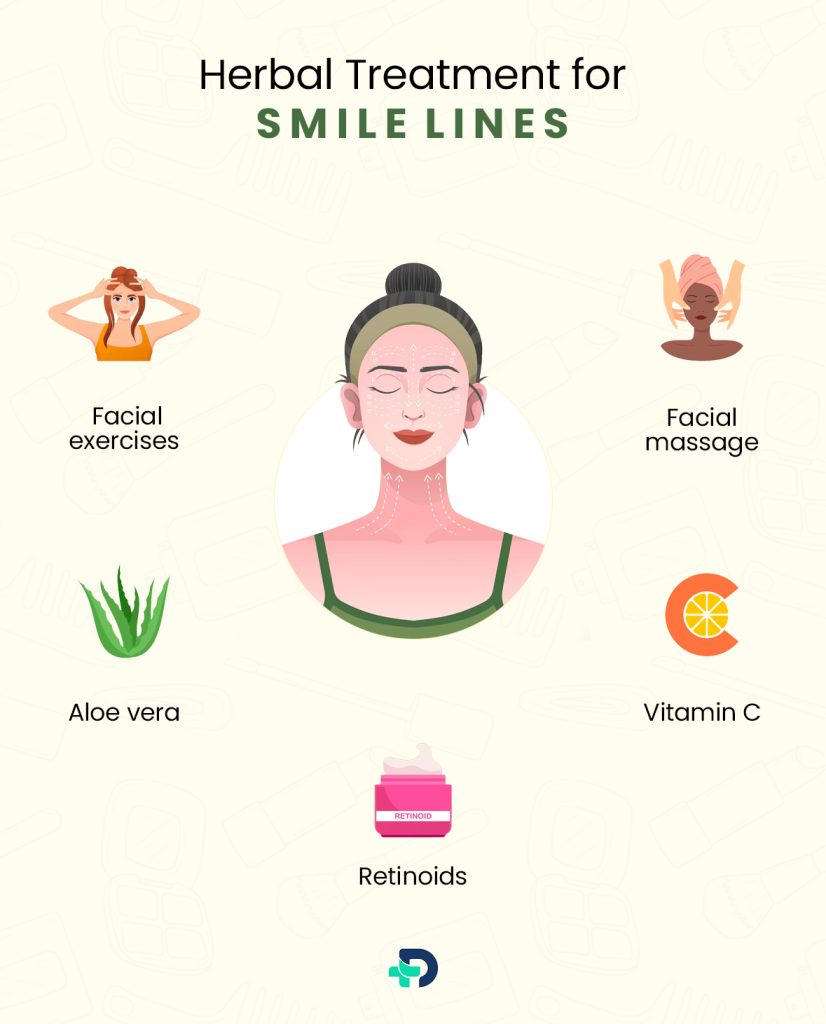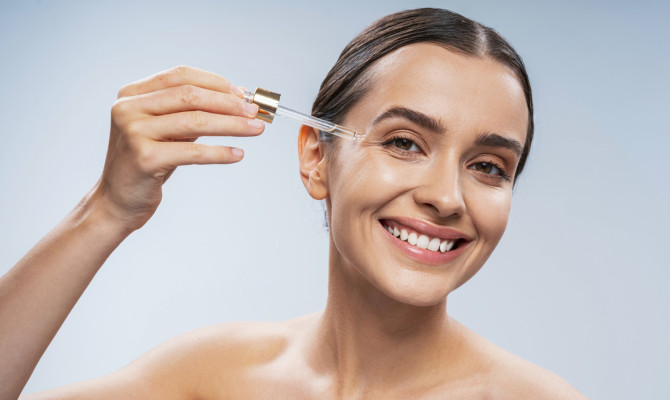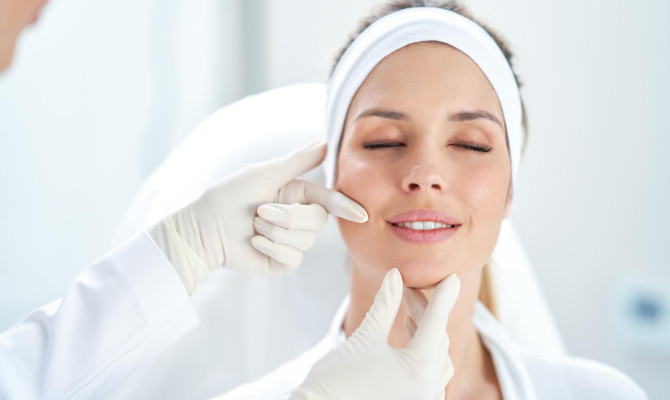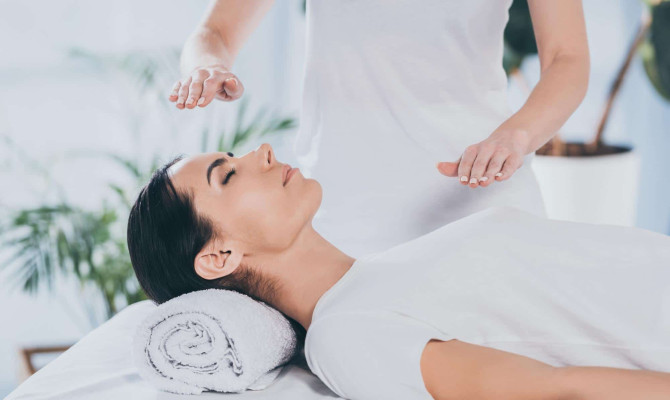Everything About Smile Lines Botox, Purpose, Side Effects & Treatment

- Botox
- 21 Sep 2023
Introduction
Smile Lines
The nasolabial folds are skin creases that extend from the sides of the nostrils to the corners of the mouth. They are also known as smile or giggle lines. Especially if you smoke or don’t shield your skin from the sun, the creases can become pronounced and permanent as you age. Some treatments can diminish their appearance.

Smile Lines
What are Nasolabial Folds or Smile Lines ? 1 What are smile lines | Researched based study from American Academy of Ophthalmology
The nasolabial folds are skin creases that extend from the sides of the nostrils to the corners of the mouth. As you age, they may become more prominent and permanent. Often referred to as giggle lines or smile lines. Age exacerbates the prevalence of smile lines in women and men of every race.
Symptoms
Symptoms of Smile Lines
From the sides of the nose to the corners of the mouth, creases right your skin. 2 Symptoms| Researched based study from National Library of Medicine When you are younger, the creases may only appear when you smile or chuckle, disappearing when your face relaxes. Over time, however, these lines may develop into deep, permanent wrinkles that appear whether or not you are beaming. They may have a symmetrical or asymmetrical shape.
Facial Lines Botox
How does Botox Treat Facial Lines?
It’s wonderful to laugh a lot, but you might not find the accompanying wrinkles, sometimes referred to as laugh or smile lines, particularly amusing. 2 How does Botox treat facial lines? | Researched based study from National Library of Medicine
Botox is used to reduce the appearance of creases, and injections can be administered around the mouth to eliminate smile lines. Small quantities of botulinum toxin (also known as Botox) are injected around the mouth to relax and freeze the muscles. This reduces the appearance of dynamic wrinkles, which are frequently the result of recurrent muscle movement.
Manufacturers make Botox injections with very tiny doses of Botulinum toxin. The substance has the ability to temporarily paralyze muscles, which can be advantageous for patients with various muscle or nerve disorders. 2 How does Botox treat facial lines? | Researched based study from National Library of Medicine
Commercial Botulinum toxin preparations include:
- Botox is onabotulinumtoxin A.
- Neurotoxin abobotulinumtoxin A (Dysport)
- Xeomin (incobotulinumtoxin A)
- Myobloc (rimabotulinumtoxin B)
- Jeuveau’s prabotulinum toxin A
People use the term “Botox” to characterize all of these products, despite the fact that Botox is a registered trademark owned by a single company.
Typically, the effects of the procedure last between three and six months.
Eligibility
Who can take Botox Injections?
You must be at least 18 years old and in good health to receive botulinum toxin injections.
Some individuals should not receive botulinum toxin. They consist of those who 1 Who can take Botox injections? | Researched based study from American Academy of Ophthalmology :
- neuromuscular illness (such as multiple sclerosis or myasthenia gravis).
- pregnant or lactating mothers
- possess a deficiency in certain facial muscles
- have ptosis (drooping eyelids), deep facial scarring, or uneven facial features (when features differ on each side of the face).
- have skin issues close to the injection site
If you intend to receive botulinum toxin injections, you must inform your physician of your medical history and the prescription medications, vitamins, and herbal supplements you currently take. 1 Who can take Botox injections? | Researched based study from American Academy of Ophthalmology
Purpose
Cosmetic Purpose of Botox
Botox is used primarily to reduce the appearance of facial creases.3 Purpose | Researched based study from American Academy of Dermatology Botox injections are, according to the American Board of Cosmetic Surgery, the most prevalent cosmetic procedure in the United States. In 2016, over 7 million individuals received Botox injections. Depending on the sort of treatment, the effects are temporary, lasting 3–12 months. 3 Purpose | Researched based study from American Academy of Dermatology
People frequently request injections in the following facial areas:
- Creases called scowl lines, glabellar lines, or elevens.
- The creases around the eyes are called crow’s feet.
- There are horizontal creases on the brow.
- The corners of the mouth have creases.
- “Cobblestone” facial epidermis.
However, the FDA has only authorized the use of the injections around the eyes and on the forehead.
Mechanism
How does Botox Work to Treat Facial Lines?
Smile lines are creases of varying depths that appear at the corners of the mouth. They can be caused by sun exposure, smoking, or simply by the natural aging process. As suggested by the name, they may be more noticeable when you smile 2 How does Botox work? | Researched based study from National Library of Medicine.
Botox is a nonsurgical treatment that temporarily paralyzes or diminishes the muscle that has been injected. Your dermatologist or plastic surgeon will inject the substance into the facial muscles beneath your skin using a small needle. Within a few days, your creases should be less noticeable.
Consequences
Adverse Consequences of Botox
Botox injections are generally well tolerated, and adverse effects are uncommon. However, depending on the reason for the injections and the individual’s response, Botulinum toxin can result in the following adverse effects 2 Adverse Consequences of Botox | Researched based study from National Library of Medicine:
- Fatigued eye as a result of cosmetic use
- Gastric distress
- Lack of feeling
- Mild pain, edema, or bruising at the injection site are common.
- Migraine
- Temporarily drooping eyebrow
- Temporarily undesirable muscle weakness or immobility
- Urinary issues after urinary incontinence treatment
- Deterioration in neuromuscular disorders
- Following treatment for strabismus, spatial disorientation or double vision may occur.
- Corneal ulceration following blepharitis treatment
- Events involving the cardiovascular system, such as arrhythmia and myocardial infarction
Botox should not be used if a person has:
- An intolerance or allergy to it
- Infection at the site of injection
- Concerns exist that, depending on the type of treatment, Botox’s effects may extend beyond the injection site, potentially causing symptoms such as breathing difficulties.
Some individuals are more susceptible than others, and genetic factors may play a role. In addition, some individuals who receive injections of Botulinum toxin type A develop antibodies that render subsequent treatments ineffective.
Procedure
What happens during Botox Injections?
When injected, botulinum toxin inhibits certain nerve signals that cause muscles to contract. Relaxing the musculature reduces the appearance of wrinkles. This effect lasts approximately three to six months. After that, muscle movement resumes and wrinkles reappear. 1 What happens during Botox injections?| Researched based study from American Academy of Ophthalmology
Before injecting botulinum toxin, your doctor may numb the injection site with an anesthetic ointment. Then, the medication will be injected into specific facial muscles. This takes only a few minutes and can be performed in the doctor’s office. Ask your physician what activities you should avoid immediately following treatment.
Outcome
What to Anticipate following Botox for Smile Line?
Typically, recovery from this procedure is minimal. Expect the following after receiving Botox for smile lines 5 What to expect after treatment| Researched based study from American Academy of Dermatology:
- After the procedure, you will be able to resume most normal activities, including driving yourself home and returning to work.
- After the procedure, do not lie down on your face or contact the area for at least four hours.
- Wait 24 hours before engaging in exercise or other strenuous activity.
- You may experience a mild stinging or tingling sensation for a few days.
- After the procedure, you will begin to see results within 3 to 6 days, with maximal results occurring approximately 14 days later. 5 What to expect after treatment| Researched based study from American Academy of Dermatology
- Botox treatments should be repeated every 3 to 6 months for optimal results, as the results are not permanent.
Botox vs Dermal
Botox vs Dermal Fillers for Smile Lines
Botox and fillers are both injectables used to treat facial creases. While Botox relaxes the muscles, dermal fillers plump and fill the epidermis. Botox is commonly used to treat dynamic creases caused by muscle movements, such as smile lines, crow’s feet, and forehead lines 4 Solutions| Researched based study from DermNet.
Fillers can be used to augment areas of the face with static wrinkles induced by a loss of collagen. Additionally, fillers have an extended duration, with some lasting up to two years before requiring another treatment.
Both procedures carry risks, but fillers may be riskier as they can cause an allergic reaction in uncommon cases.
Herbal Treatment

Herbal Treatment for Smile Lines
There are some natural remedies you can attempt if you do not wish to pursue conventional treatment. These consist of 4 Herbal Treatment| Researched based study from DermNet:
- Facial exercises – These exercises target the muscles around the mouth, cheekbones, and jawline through specific facial movements. Regular facial exercises can strengthen and tone these muscles, thereby reducing the appearance of smile lines.
- Facial massage – Regular facial massage can enhance blood circulation and lymphatic drainage, promote skin health, and reduce fine lines and wrinkles, including smile lines.
- Aloe vera – Aloe vera is a natural anti-inflammatory that can enhance skin elasticity and reduce the appearance of fine lines and wrinkles. Regular application of aloe vera gel to the epidermis can reduce the appearance of smile lines. 4 Herbal Treatment| Researched based study from DermNet
- Vitamin C – Vitamin C is an effective antioxidant that protects the skin from free radical damage. According to studies, it can help increase collagen production, thereby reducing the appearance of smile lines.
- Retinoids – Retinoids, such as Retinol and Tretinoin, are a common vitamin A derivative found in anti-aging cosmetic products. They reduce the appearance of smile lines by increasing cell turnover and collagen production, which contributes to their effectiveness. Retinoids should only be used under the supervision of a physician, as they can cause skin sensitivity and irritation.
While these natural remedies can help reduce the appearance of smile lines, they may not be effective for everyone, and their effectiveness is limited.
Solutions
Solutions for Smile Lines
In addition to natural remedies, the following hygiene products can help reduce the appearance of your smile lines: 4 Solutions| Researched based study from DermNet
- Moisturizers – Maintaining hydrated skin reduces the appearance of smile lines. Look for an emollient with hyaluronic acid or glycerin, which can help draw moisture into the skin and keep it hydrated.
- Serums – Serums are light, contain a high concentration of active ingredients, and can penetrate the epidermis deeply. Antioxidant serums, such as vitamin C, Retinoids, or peptides, can help stimulate collagen production. 4 Solutions| Researched based study from DermNet
- Sunscreen – Protecting the skin from sun injury is essential for reducing the appearance of smile lines and preventing their progression. Even on cloudy days, use a broad-spectrum sunscreen with at least SPF 30 and apply it daily.
- Peptides – Peptides are short chains of amino acids that can stimulate the production of collagen in the epidermis. Consider purchasing hygiene products that contain peptides, such as copper peptides or palmitoyl peptides.
- Alpha-hydroxy acids (AHAs) – AHAs are a group of acids that can aid in exfoliating the skin and stimulating cell turnover in order to reduce the appearance of fine lines and creases. Consider purchasing hygiene products with AHAs, such as glycolic or lactic acid. People with extremely oily skin will achieve a similar result with beta-hydroxy acids, whereas Polyglutamic-hydroxy acid is ideal for those with more sensitive skin.
Lowering Risk
How to Lower the Risk of Developing Nasolabial Folds?
Certain strategies can reduce the likelihood of developing giggle lines, delay their onset, and diminish their prominence 1How to lower risk| Researched based study from American Academy of Ophthalmology :
- Consume a nutritious diet and get plenty of exercise and rest. If you are healthier, your complexion will be healthier.
- Use nothing on your skin that irritates or burns unless it has been prescribed by a doctor. Irritation can accelerate the aging process.
- Avoid using the sun and tanning booths to achieve a tan. The ultraviolet rays can hasten wrinkling and aging. Additionally, it can cause age marks and skin cancer.
- Stop smoking or do not commence.
- You should sleep on your back. This can assist gravity in combating laugh lines. If you are a side sleeper, attempt to alternate positions frequently.
- Utilize a delicate cleanser and moisturizer a minimum of twice per day. Know the components of your hygiene products—request recommendations from your dermatologist based on your skin type and personal objectives.
- Every day, use a sunscreen with at least SPF 30. Reapply sunscreen every two hours, or more frequently if perspiring or swimming.
Takeaway
Facial Lines Botox – Takeaway Points
Botox is a cosmetic treatment that momentarily paralyzes skin muscles by injecting a purified form of botulinum toxin into them. When instilled into the muscles surrounding the mouth, it can reduce the appearance of smile lines and prevent them from creasing or becoming deeper.
Some advantages of using Botox to treat facial lines:
- It is a minimally invasive procedure that takes of brief duration.
- It can produce results in a matter of days that can last for several months.
- It can help reduce the appearance of fine lines and creases, resulting in a more youthful and supple complexion.
However, there are some disadvantages to using Botox for smile lines:
- It is a temporary treatment, and its effects will gradually diminish.
- It can be expensive, with costs varying depending on the location and amount of Botox required.
- Botox can cause adverse effects such as asymmetry, bruising, swelling, and headaches, and you must adhere to the aftercare instructions.
- It only works for minor smile lines
Any feedback on this article?
 This Articles content was accurate
This Articles content was accurate Very Informative Article
Very Informative Article I have a question or a comment
I have a question or a comment
 This article contains inaccurate content
This article contains inaccurate content This article was not helpful
This article was not helpful I have a question or a comment
I have a question or a comment
We appreciate your helpful feedback!
Checkout our social pages
References
-
American Academy of Ophthalmology
What are smile lines | Who can take Botox | What happens | How to lower risk
-
National Library of Medicine
How does Botox treat | How does botox work | Symptoms
-
American Academy of Dermatology
Purposes
-
DermNet
Solutions | Herbal treatment
-
American Academy of Dermatology
What to expect after treatment



































